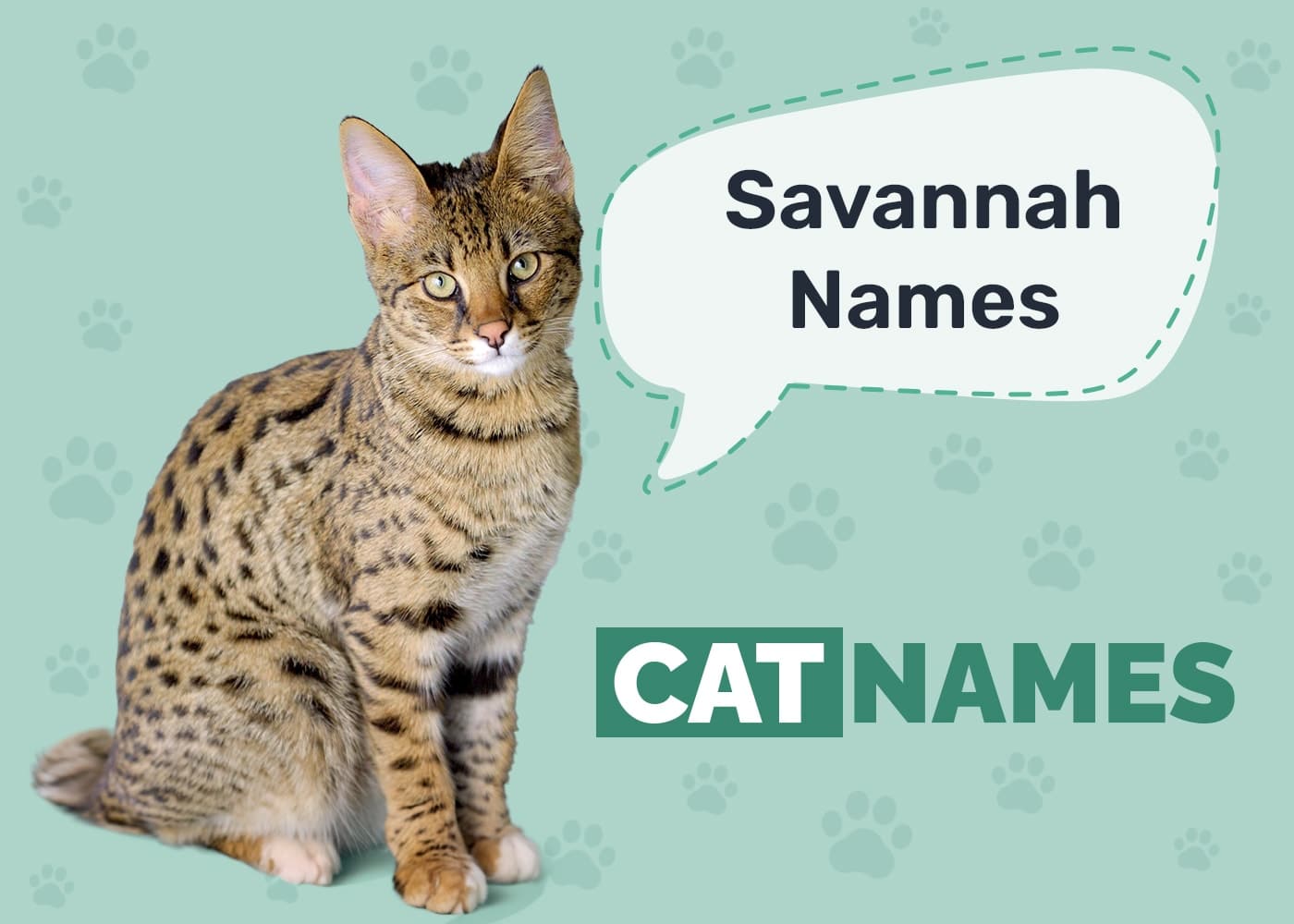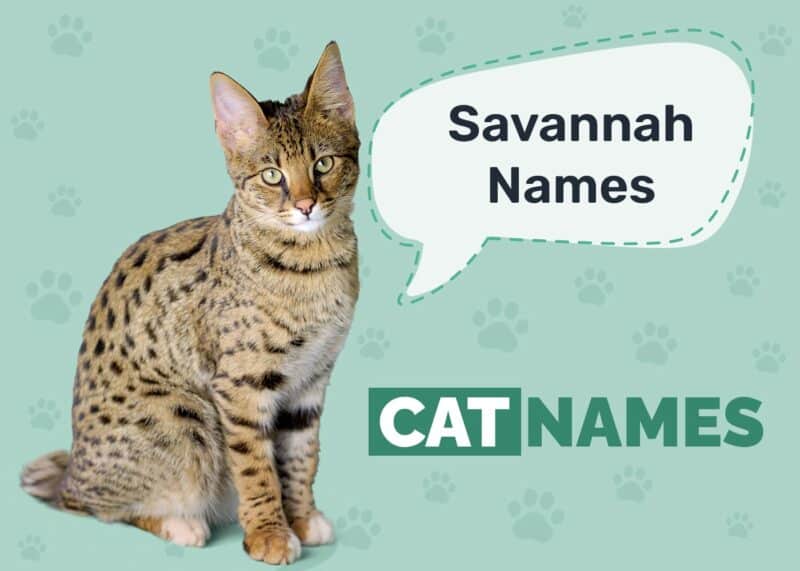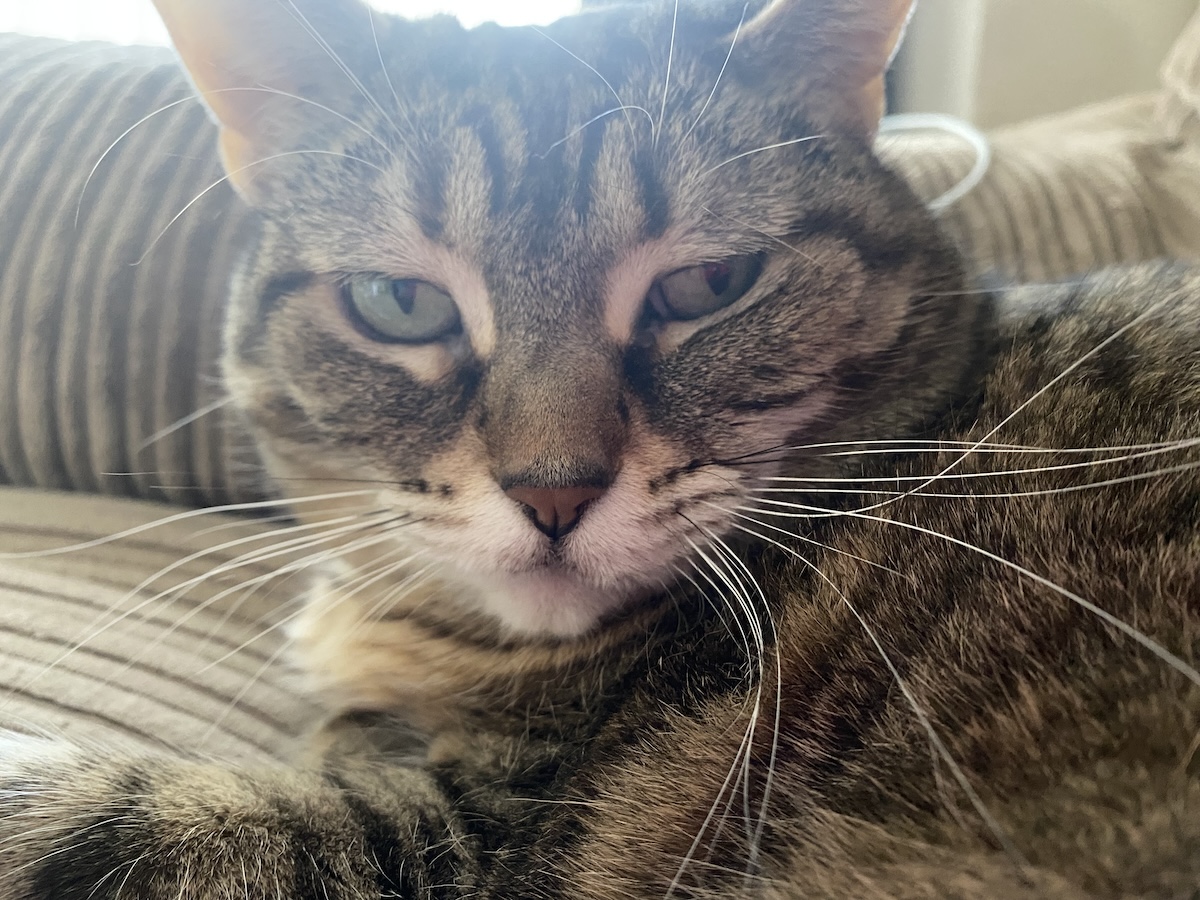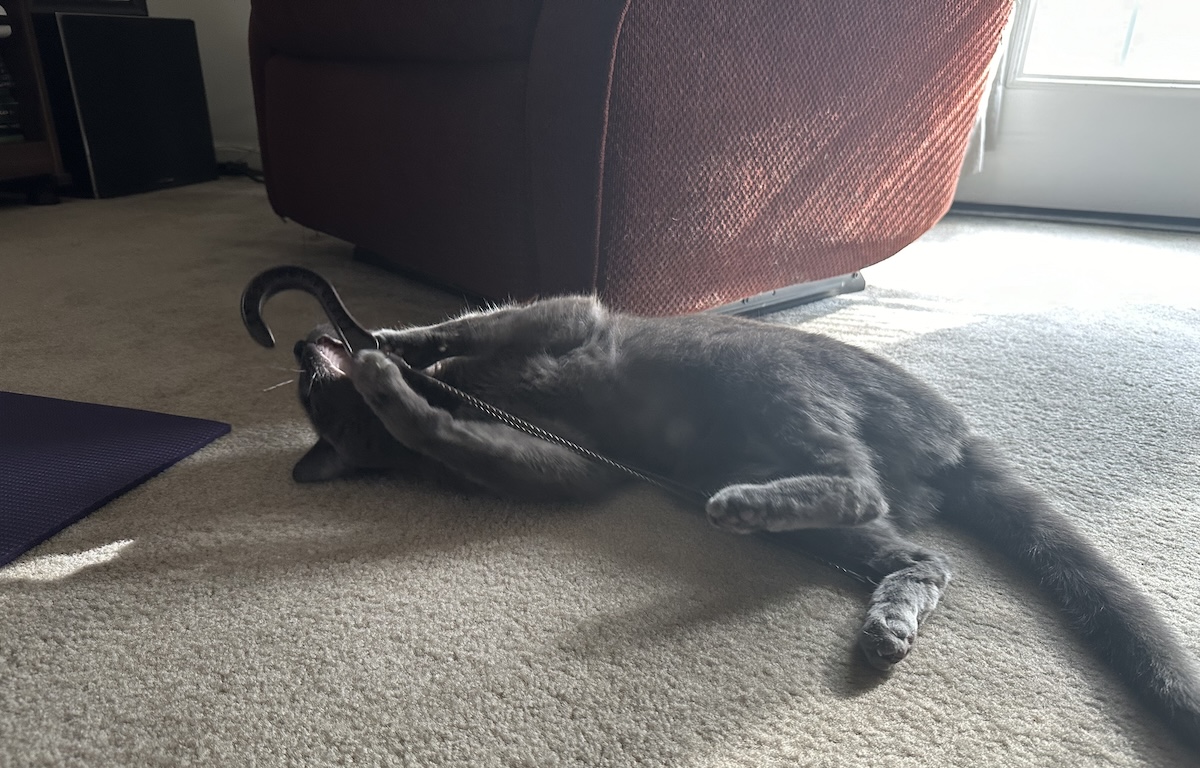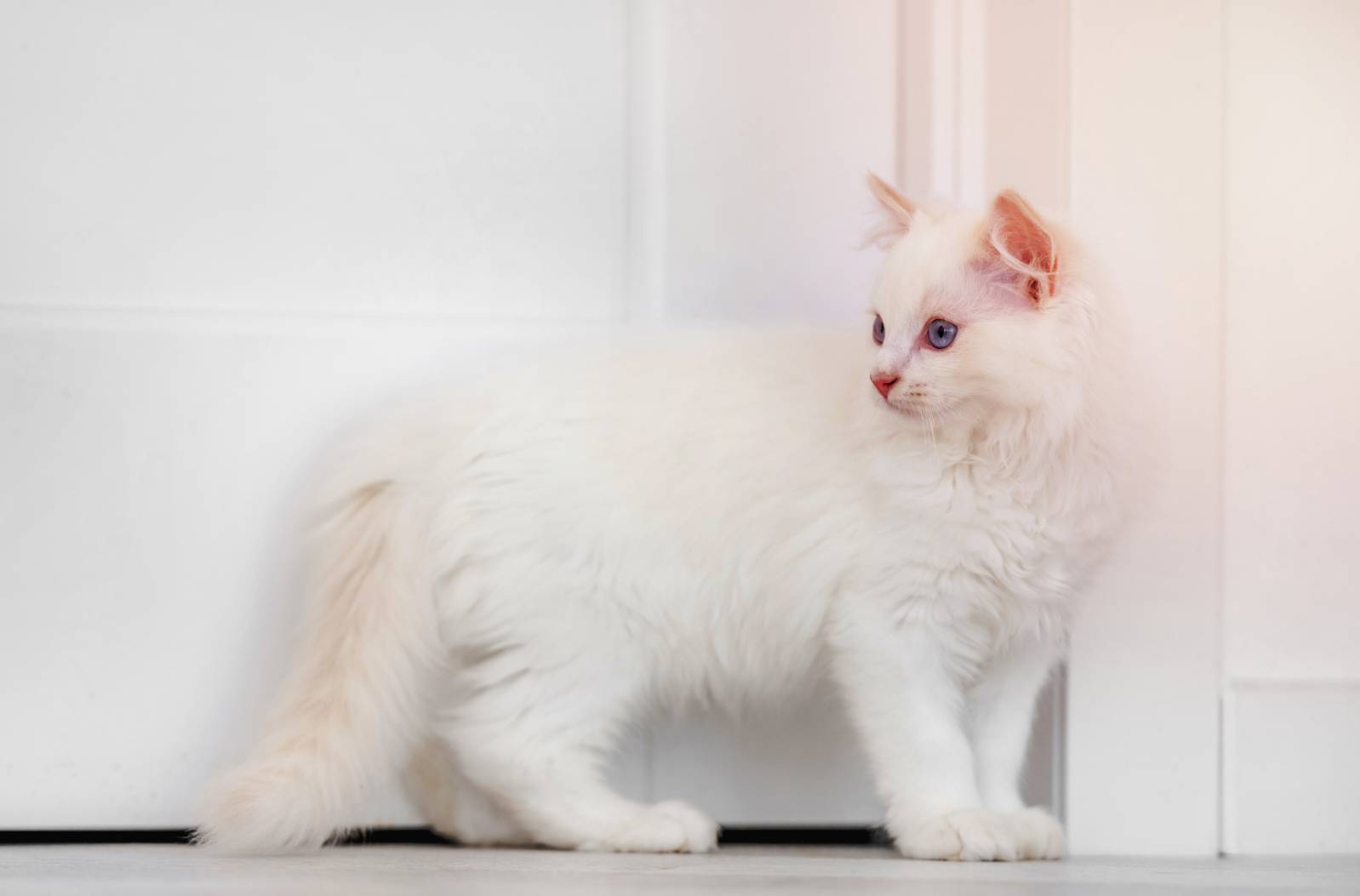Click to Skip Ahead
Savannah cats are incredible specimens, providing an exotic quality to domestic life. They definitely fare best in a cat-savvy home with owners who can give the unique style of care they require.
With the homecoming of your newest furbaby, you’ll want to find the perfect name to match. Savannah cats are amazingly unique, and we found many names we think you might enjoy.
How to Name Your Savannah Cat: 5 Tips to Make it Fun
Naming your Savannah cat can be challenging. Tons of picks would make excellent titles for this breed. If it’s your first time owning one of these beautiful cats, you’ll want something exciting and exotic as they are.
But sometimes, we all need a little help brainstorming. How can you make that final decision with so many good choices? It might be simpler than you think.
1. Make It a Group Effort
Do you share your home with others? Gather up the whole pack and toss out name ideas. Maybe they’d like a say. Once everyone contributes, it makes homecoming much more personal, and everyone feels connected.
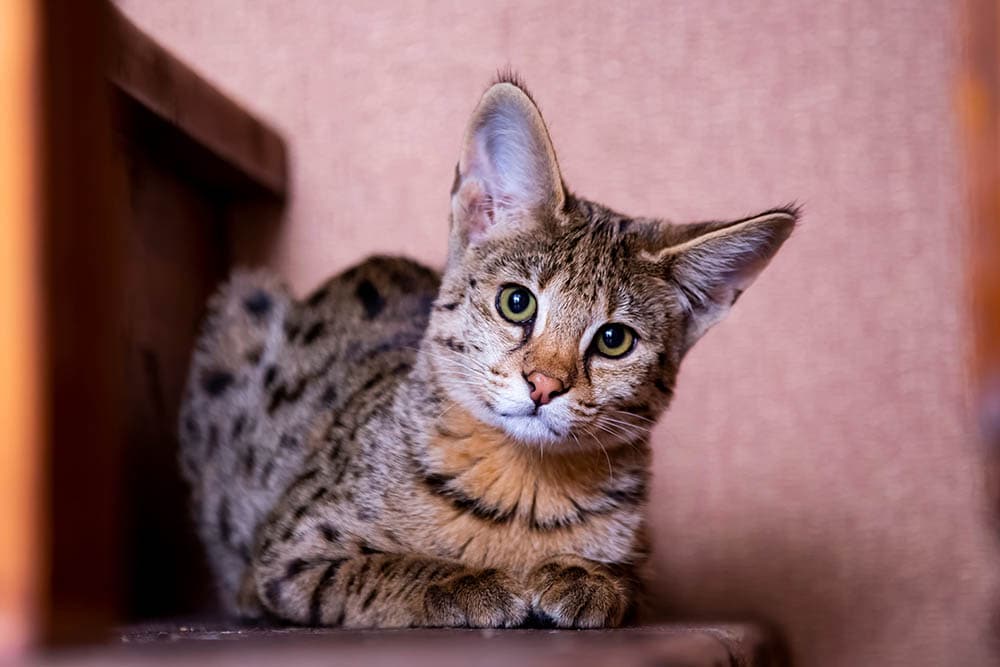
2. Take It to Social Media
You know that everyone on social media is just waiting for something to pipe in about, so why not ask about their opinion? Gather a few of your favorites and make a poll—or drop a picture and ask everyone for suggestions.
3. Name Based on Personality
Every cat is different—but they just might remind you of something familiar. If your cat is acting a specific way, it could really help you with the process of elimination. Are they very fast? Maybe you could name them Sonic. Do they act like big goofballs? Perhaps a name like Patrick Star would do them well.
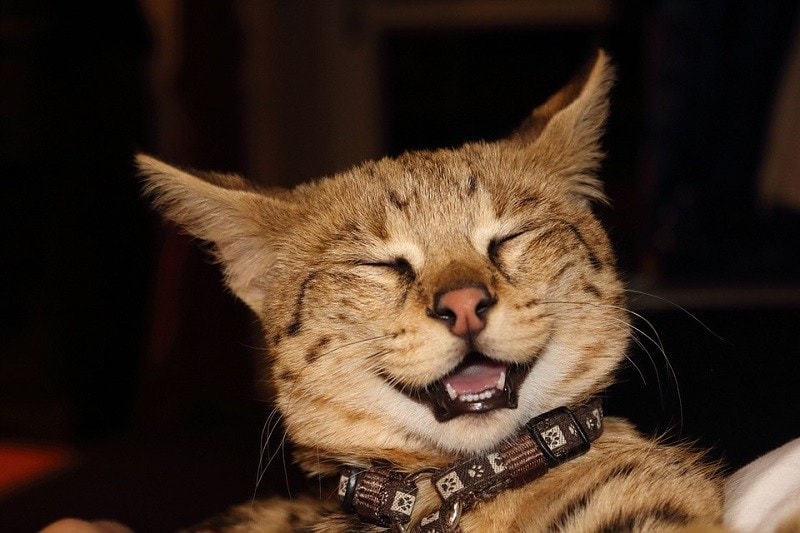
4. Pick a Name at Random
When in doubt, leave it to fate. Gather up the names that you want—and you can do it the digital or old-fashioned way. Simply write names on scrap pieces of paper or input them into a random picker web page and let luck decide for you.
5. Keep the Original Name
If you like it enough, you can just keep it as is! Many kittens or rescues already have names from their current caretaker. This is especially true if they respond to and acknowledge the name as their own.
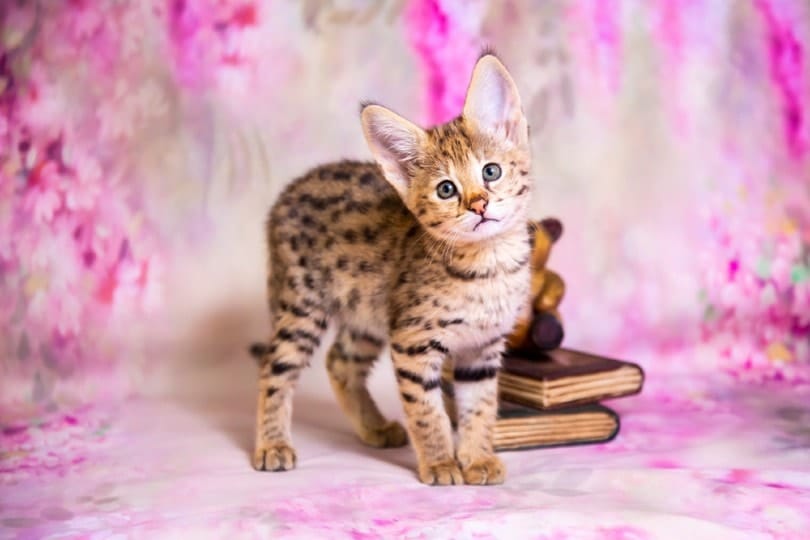

African Names for Your Savannah Cat
Serval cats are native to the continent of Africa. Since that makes up half your Savannah’s DNA, it’s only appropriate to search for a name that celebrates their heritage. So, here is a list of African names along with their meanings.
Male Names
- Abbo—A condiment
- Chidi—Strongest god
- Dabir—A brilliant teacher
- Eshe—Immortal
- Eze—A king
- Mikaili—God’s messenger
- Obi—Charming aroma
- Sudi—One who brings luck
- Jaheim—Raised up
- Jelani—One who is mighty
- Zaire—River
- Namib—Meaning “vast place”, also a desert in Africa
- Jumah—Friday born
- Canelo—Sufficient
- Anane—Fourth son
- Ato—Saturday born
- Belay—Above everyone
- As—Agility of a leopard
- Carrizo—Swamp, wetlands
- Jengo—Reddish skin
- Abdou—Focus on work
- Ife—Love
- Juma—Friday born
- Abeer—Fragrance
- Asko—Power and strength
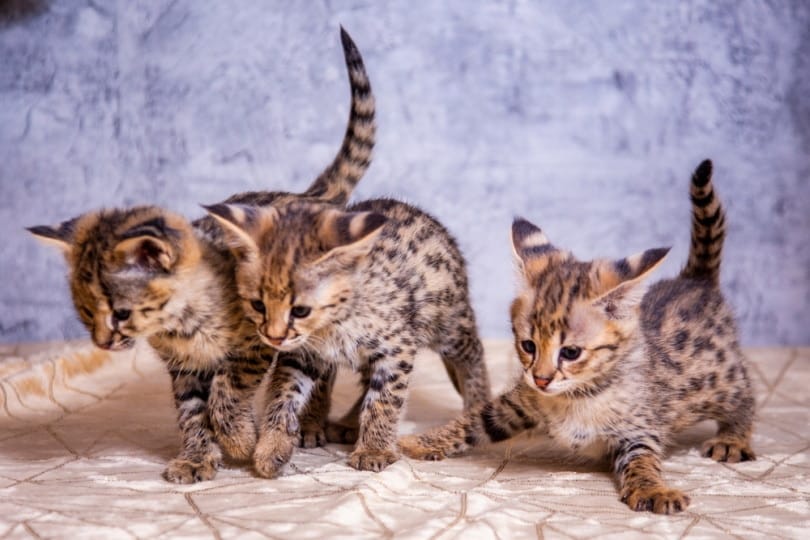
Female Names
- Akua—A child born on Thursday
- Kenya—Flower of the garden
- Lissa—Supreme mother goddess
- Palesa—A majestic flower
- Gheche—Small
- Fanaka—Prosperity
- Rashida—The righteous one
- Kia—Season beginning
- Marini—Fresh, healthy
- Samira—She who is from heaven
- Naja—Indifferent to pleasure
- Taleisha—Blooming life
- Zahra—Shining flower
- Tomika—A wealthy person
- Walta—Shield
- Neilah—Gift from the town
- Tiombe—A shy person
- Njoki—She who returned
- Nala—Lioness
- Sadaka—A spiritual offering
- Zola—Ball of earth
- Wanja—The one from without
- Kianga—Beams of the Sun
- Wangera—A traveler
- Kione—Came from nowhere
Ancient Egyptian Names for Your Savannah Cat
Egypt is located in Africa, but we want to delve even further into continental history and geography. Back in the days of Cleopatra, cats were revered for their beauty, companionship, and god-like metaphysical powers.
Give your outstandingly large, exotic Savannah cat a name that will embrace its royal ancestry. After all, it is the primary home of early domesticated cats!
Male Names
- Asim—Protector
- Ur—Great
- Gyasi—Wonderful
- Omari—High born
- Sadiki—Faithful
- Hanbal—Purity, pristine
- Horus—God of light
- Jabari—A man known for his bravery
- Makalani—Clerk
- Masuda—A happy boy
- Menefer—Of the beautiful city
- Moshe—Drawn out of the water
- Ozymandias—King of King
- Nephi—Founder of the Nephite people
- Odion—The yellow daffodil flower
- Ramses—Son of Ra
- Seb—God of the earth
- Zoar—King of kings
- Osirus—God of the Underworld
- Horus—Son of Isis
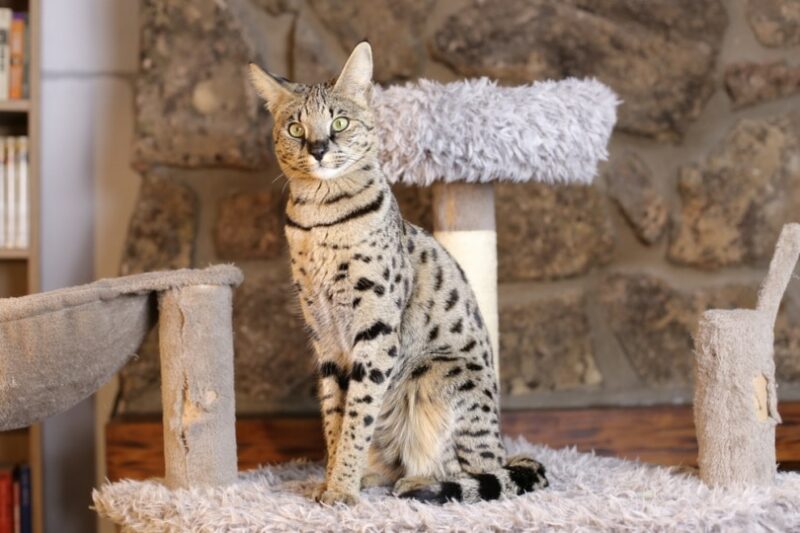
Female Names
- Akila—Intelligent
- Naunet—Goddess of the ocean
- Dalila—Gentle
- Masika—Born during rain
- Ife—Love
- Dalilah—Languish
- Hathor—Goddess of motherhood and fertility
- Bastet—She of the ornament jar
- Nut—Sky
- Neith—Standing high above others
- Nenet—Spiritual and divine
- Lapis—Azure blue stone
- Mona—Wishes or desires
- Zahra—Flower
- Cleopatra—Famous ruler
- Sara—Princess
- Eman—Faith
- Layla—Night
- Marwa—Stone or mountain
- Heba—Gift
Character Names for Savannah Cats
We gain so much inspiration from our favorite books and movies. Getting attached to a character in a film or novel can feel very personal, so why not make a tribute to an old favorite?
Male Names
- Aslan—The Lion, the Witch, and the Wardrobe
- Professor X—X-Men
- Miles—Spider-Man
- Geralt—The Witcher
- Manny—Ice Age
- Toad—Mario
- Caden—Riley’s Adventures
- Fa Zhou—Mulan
- Mambo—Happily Never After
- Cheech—Cheech & Chong
- Caillou—Caillou
- Sambo—Looney Tunes
- Carl—meet the Robinsons
- Zazu—The Lion King
- Tamatoa—Moana
- Lavernius—Red vs. Blue
- Catgut—Pound Puppies
- Oscar—Shark Tale
- Cheese Sandwich—My Little Pony
- Koopa—Super Mario Bros
- Spyro—Spyro
- Charlie—All Dogs Go to Heaven
- Nacho—Nacho Libre
- Napoleon—Napoleon Dynamite
- Freddie—Freddie Got Fingered
- Lahey—Trailer Park Boys
- Linus—Snoopy
- Simba—The Lion King
- Alex—Madagascar
- Neo—The Matrix
- Dale—Step Brothers
- Binx—Meet the Fockers
- Huckleberry—Adventures of Huckleberry Finn
- Stewie—Family Guy
- Cartman—South Park
- Meatwad—Aqua Teen Hunger Force
- Casper—Casper
- Moby—Moby Dick
- Sullivan—Monsters Inc.
- Irving—Bad Grandpa
- Terrence—Yes Man
- Zed—Year One
- Dungarees—Your Highness
- Monty—Monty Python and the Holy Grail
- Kieran—Dinner for the Schmucks
- Berlioz—The Artisocats
- Klaus—Umbrella Academy
- Copperbottom—Robots
- Cletus—The Amazing Spider-man
- Chumpkins—P. King Duckling
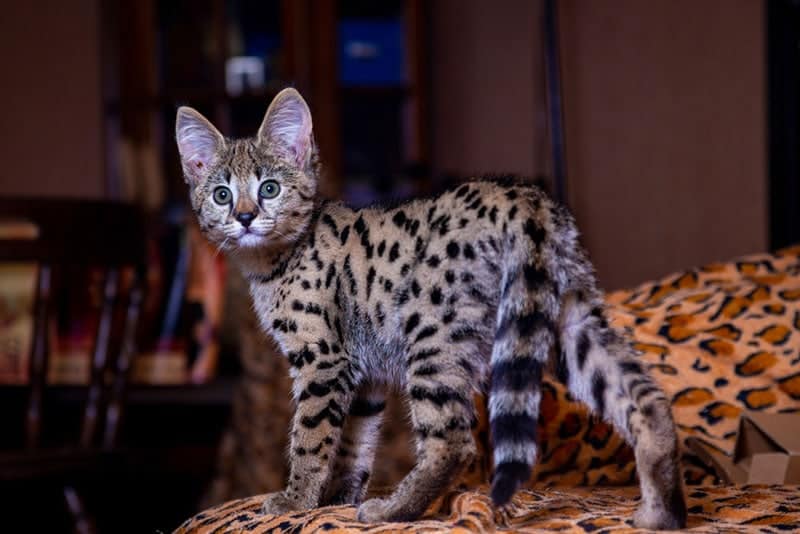
Female Names
- Miss Frizzle—The Magic School Bus
- Maleficent—Sleeping Beauty
- Trinity—The Matrix
- Buffy—Buffy the Vampire Slayer
- Marian—Robin Hood
- Juno—Juno
- Merida—Brave
- Matilda—Matilda
- Clementine—Eternal Sunshine of the Spotless Mind
- Some—Cloud Atlas
- Penny—The Rescuers
- Thalia—Hercules
- Annie—Annie
- Coraline—Coraline
- Pepper—Iron Man
- Vixey—Fox & the Hound
- Punky—Punky Brewster
- Moon—Sailor Moon
- Georgette—Oliver & Company
- Buttercup—The Princess Bride
- Prim—The Hunger Games
- Nova—Planet of the Apes
- Faline—Bambi
- Anda—Brother Bear II
- Baylee—Dinosaur
- Ariel—The Little Mermaid
- Moira—Schitt’s Creek
- Lilo—Lilo & Stitch
- Adelaide—Aristocrats
- Violet—The Incredibles
- Zooey—Sofia the First
- Honey—Dr. No
- Furiosa—Mad Max: Fury Road
- Pris—Blade Runner
- Clarice—Silence of the Lambs
- Leia—Star Wars
- Colette—Ratatouille
- Evangeline—Princess & the Frog
- Jasmine—Aladdin
- Quinn—Suicide Squad
- Francine—Arthur
- Tiana—The Princess and the Frog
- Helga—Hey Arnold
- Pearl—Spongebob Squarepants
- Kimmie—Full House
- Mona—Drowning Mona
- Wilma—The Flintstones
- Sally—The Nightmare Before Christmas
- Bellatrix—Harry Potter
- Vanellope—Wreck-It Ralph
Athletic Names for Savannah Cats
Savannah cats are highly athletic creatures with long bodies and impressive physical capabilities. So, if you want to give them a name that matches this character trait, here are some primarily unisex names you can consider.
Unisex Names
- Flash
- Zippy
- Scat
- Tigger
- Yoshi
- Kinetic
- Shockwave
- Optimus
- Speedy
- Sonic
- Turbo
- Pounce
- Cheetah
- Lightyear
- Hulk
- Scout
- Bolt
- Gump
- Peppy
- Frisbee
- Daytona
- Ferrari
- Nimble
- Sprint
- Swifty
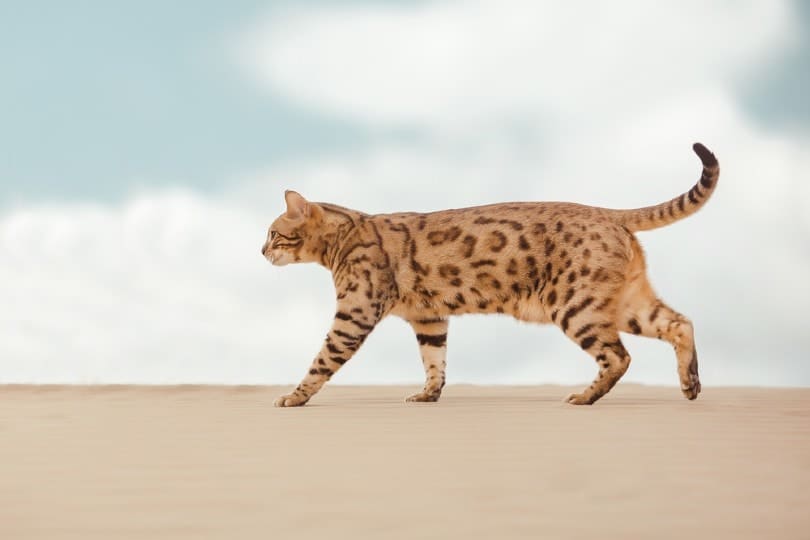
Food Names for Your Savannah Cat
If you are a foodie and think these names are too cute, you can always name your cat after a delicious dish. The name possibilities are endless, even beyond what we have here! So, don’t be afraid to draw some inspiration.
Unisex Names
- Pepper
- Pumpkin
- Taco
- Oreo
- Mochi
- Peaches
- Sushi
- Mocha
- Bleu
- Velveeta
- Coconut
- Potato
- Honey
- Sugar
- Paw Paw
- Tart
- Cookie
- Biscuit
- Lemon
- Nacho
- Marzipan
- Praline
- Twix
- Chiclet
- Cob
- Pancake
- Bubblegum
- Pops
- Raisin
- Oatmeal
- Cocoa
- Ravioli
- Tatertot
- Peanut
- Meatball
- Poptart
- Honeybun
- Trix
- Merlot
- Pepsi
- Fizzy pop
- Tortellini
- Peach
- Hibachi
- Slaw
- Schnitzel
- Taffy
- Sweetie Pie
- Sweet Pea
- Okra
- Twinkie
- Pound Cake
- Cupcake
- Kale
- Marshmallow
- Pizza
- Cake
- Fudge
- S’more
- Falafel
- Rolo
- Pesto
- Fish
- Noodle
- Fries
- Ice
- Peeps
- Slim Jim
- Chalupa
- Beefy
- Porkchop
- Toast
- Jiffy
- Almond Joy
- Pecan
- Walnut
- Pistachio
- Reeses
- Mango
- Hershey
- Kit-Kat
- Papaya
- Apricot
- Minestrone
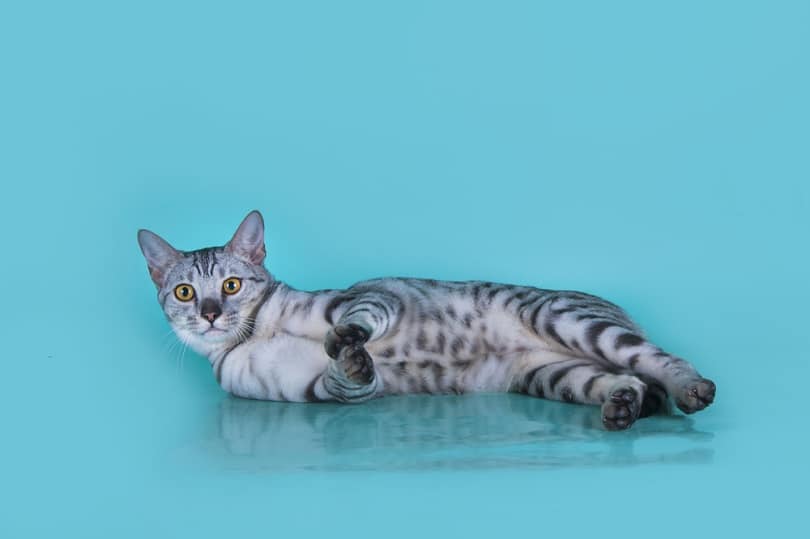
Elegant Names for Your Savannah Cat
You will be continually impressed by your Savannah cat’s precision, grace, and agility. Whether they are on the prowl or climbing so efficiently up your cabinets and countertops, you can’t deny the effortless athleticism they display.
Here are some names that match the display of a Savannah cat.
Male Names
- Ira
- Elijah
- Imari
- Raja
- Winston
- Errol
- Lazarus
- Solomon
- Raul
- Augustus
- Silvan
- Hugo
- Percival
- Russo
- Eckhart
- Ivan
- Giovanni
- Niles
- Tyco
- Shiloh
- Tasmin
- Henry
- Oliver
- Egbert
- Aldrich
- Constantine
- Cyril
- Ian
- Ezra
- Griffin
- Vito
- Horace
- Pavel
- Edwardo
- Julian
- Nikolai
- Richmond
- Reginald
- Valentino
- Ulysses
- Tarantino
- Mungo
- Nikolai
- Richmond
- Reginald
- Valentino
- Ulysses
- Lachlan
- Rathbone
- Edgar
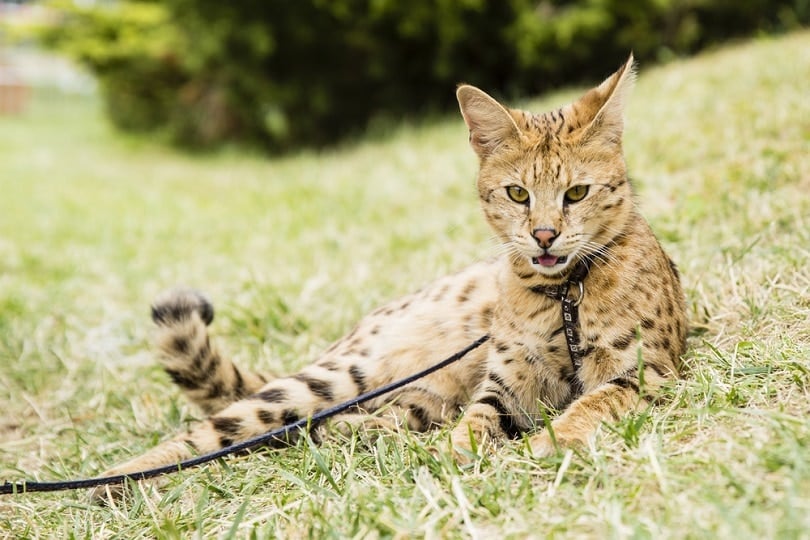
Female Names
- Georgette
- Bernice
- Anastasia
- Everly
- Winona
- Vivian
- Tatiana
- Natalie
- Bianca
- Daphne
- Phoebe
- Persephone
- Priscilla
- Madonna
- Elena
- Olivine
- Winifred
- Serafina
- Hera
- Dinah
- Imogen
- Guinevere
- Felicity
- Nadine
- Naomi
- Raven
- Onika
- Vera
- Cecily
- Any
- Olive
- Amelia
- Sedona
- Raven
- Marlena
- Magdelena
- Evangeline
- Blythe
- Gretchen
- Opal
- Imogen
- Grace
- Brunhilda
- Viola
- Zinnia
- Francesca
- Zula
- Garnet
- Roma
- Phoebe
Random Names for Your Savannah Cat
Sometimes, there’s no rhyme or reason for random names that pop up. Here are a few miscellaneous names to sift through before you go—so maybe you’ll find another take that catches your eye!
Male Names
- Quincy
- Ringwald
- Gavel
- Carvin
- Tasmin
- Lucius
- Solomon
- Gulliver
- Caesar
- Ghost
- Rango
- Millgrove
- Bilbo
- Jasper
- Copper
- Deacon
- Frost
- Ragu
- Gubbins
- Everest
- Taki
- Altas
- Viceroy
- Gibson
- Rizzo
- Onyx
- Shiver
- Cedar
- Boswell
- Jenkins
- Gaston
- Rance
- Orville
- Herman
- Earl
- Yuri
- Tesla
- Dino
- Derry
- Chauncey
- Dean
- Leroy
- Banjo
- Frank
- Phelps
- Iggy
- Gunther
- Percy
- Barnaby
- Judge
Female Names
- Itsy
- Tilly
- Bonnie
- Ruby
- Fru-Fru
- Betsy
- Aggie
- Wendy
- Pipsy
- Punky
- Rossi
- Uma
- Elle
- Tibby
- Winnie
- Posy
- Jazzy
- Charlie
- Candi
- Luna
- Bella
- Vivie
- Panda
- Millie
- Kiki
- Momo
- Mittens
- Goose
- Remi
- Sunny
- Rosie
- Mamie
- Eulalie
- Bindi
- Buttercup
- Poppy
- Koopa
- Polly
- Fluff
- Salem
- Maggie
- Chachi
- Lucky
- Pixie
- Mayhem
- Gidget
- Tula
- Lily
- Margot
- Tinley
Conclusion
Naming your Savannah cat will be a lot of fun—no matter what you pick. Giving your new exotic babe a title will set the stage for the rest of your relationship. This kitty is one smart cookie and will even learn and respond to its name in no time.
So, gather up the fam, pick a few favorites, and make your final call. Hopefully, the name that stuck out most was one of the several we thought up—best of luck in your search.
See Also:
- Korean Cat Names: Ideas for Stylish & Popular Cats
- Tiger Striped Cat Names: Ideas for Unique & Exotic Cats
Featured Image Credit: Kolomenskaya Kseniya, Shutterstock

